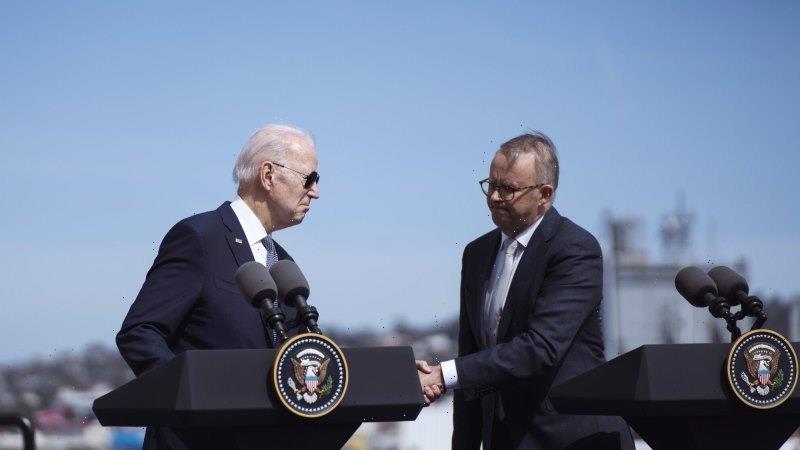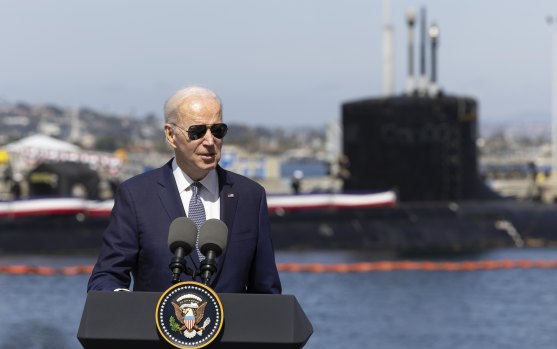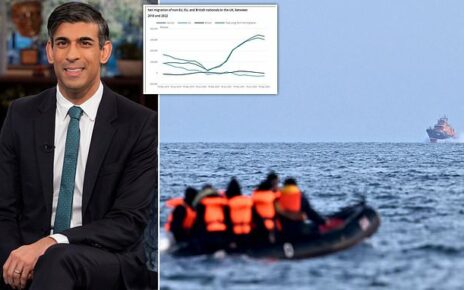San Diego: Prime Minister Anthony Albanese insists Australia will have full operational control of the nuclear submarines it will acquire under the AUKUS pact unveiled on Tuesday with US President Joe Biden and UK Prime Minister Rishi Sunak.
But like it or not, Australia has signed up for the West’s new Cold War arms race with China as America cements its stake in Indo-Pacific regional security.
US President Joe Biden during the AUKUS announcement in San Diego.Credit:Alex Ellinghausen
US officials readily acknowledge that tensions with Beijing are higher than they have been in years, and recent events – from the dramatic take-down of a Chinese spy balloon to President Xi Jinping’s pledge to build his military into a “Great Wall of Steel” – have merely added to fears about the looming threats the country poses.
In a deeply divided Congress, it’s rare for Democrats and Republicans to agree, and yet when it comes to countering China’s rise, both sides of politics are consistently taking a tougher stance. There’s even a joke on Capitol Hill that if you want bipartisan support on anything, try to find a way to tie it with China’s economic and military might – and you’re likely to get it over line.
Indeed, as an increasingly hawkish Biden declared in his State of the Union address last month: “Let’s be clear: winning the competition with China should unite all of us.”
In that context, AUKUS might represent the “single biggest leap” in Australia’s defence capabilities, but it also represents – to use the president’s words – “an inflection point in history where the hard work of enhancing deterrence and promoting stability is going to affect the prospects of peace for decades to come”.
For Australia, that hard work begins now. On the upside, if the country does end up with three Virginia-class nuclear submarines within the next decade followed by eight newly developed AUKUS submarines, it will effectively have one of the most powerful navies in the world.
But becoming a bigger player on the world stage will also come at an eye-watering cost of up to $368 billion by 2055, much of which will be used to upscale America’s industrial shipbuilding base so it can build more Virginia-class submarines to make up for the ones it sells to Australia. Provided, of course, that US Congress approves.
China, meanwhile, has angrily responded to AUKUS by accusing the countries involved of going “further down the wrong and dangerous path for their own geopolitical self-interest.”
To that end, AUKUS is a deal that comes with great reward, but also great risk – and most of it will be carried by Australia.
The plan will begin with more visits to Australian ports by US and UK submarines over the next five years, clearing the way for a fixed rotation of naval power in Perth by 2027.
But even with Tuesday’s big reveal – set against the backdrop of a US navy base in San Diego – the devil remains in the murky detail.
How will Australia operate not one but two types of nuclear attack subs when it has no prior experience? How does the navy find the tens of thousands of people it will need to not only build the ships but also become skilled enough in nuclear technology to help run them?
Can the US Congress find a way through the maze of export control laws that govern the way America shares nuclear technology? And what happens if a future administration simply changes its mind, or enters office with an isolationist plan to put America (and its subs) first?
“I do think there might a risk of a future administration changing the terms of the agreement,” says Byron Clark, a former submariner-turned sea power strategist for the Hudson Institute.
“A future administration could decide not to sell the submarines to Australia, just like a future Australian administration could decide not to buy them because they may not want to spend the money.”
While the chances of this happening appear to be slim for now, such a scenario is nonetheless emblematic of Australia’s vulnerability as ties its colours to America’s mast and navigates the choppy waters of the Indo-Pacific.
Cut through the noise of federal politics with news, views and expert analysis from Jacqueline Maley. Subscribers can sign up to our weekly Inside Politics newsletter here.
Most Viewed in World
From our partners
Source: Read Full Article



